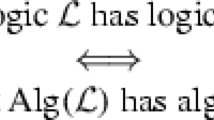Abstract
Pratt [22] defines action algebras as Kleene algebras with residuals. In [9] it is shown that the equational theory of *-continuous action algebras (lattices) is Π\(^{0}_{1}\)–complete. Here we show that the equational theory of relational action algebras (lattices) is Π\(^{0}_{1}\) –hard, and some its fragments are Π\(^{0}_{1}\)–complete. We also show that the equational theory of action algebras (lattices) of regular languages is Π\(^{0}_{1}\)–complete.
Preview
Unable to display preview. Download preview PDF.
Similar content being viewed by others
References
Andréka, H., Mikulaś, S.: Lambek calculus and its relational semantics: completeness and incompleteness. Journal of Logic, Language and Information 3, 1–37 (1994)
Bar-Hillel, Y., Gaifman, C., Shamir, E.: On categorial and phrase structure grammars, Bulletin Res. Council Israel F9, 155-166 (1960)
Buszkowski, W.: Some decision problems in the theory of syntactic categories. Zeitschrift f. math. Logik und Grundlagen der Mathematik 28, 539–548 (1982)
Buszkowski, W.: The equivalence of unidirectional Lambek categorial grammars and context-free grammars. Zeitschrift f. math. Logik und Grundlagen der Mathematik 31, 369–384 (1985)
Buszkowski, W.: The finite model property for BCI and related systems. Studia Logica 57, 303–323 (1996)
Buszkowski, W.: Mathematical Linguistics and Proof Theory, 683-736, in [24]
Buszkowski, W.: Finite models of some substructural logics. Mathematical Logic Quarterly 48, 63–72 (2002)
Buszkowski, W.: Relational models of Lambek logics. In: de Swart, H., Orłowska, E., Schmidt, G., Roubens, M. (eds.) Theory and Applications of Relational Structures as Knowledge Instruments. LNCS, vol. 2929, pp. 196–213. Springer, Heidelberg (2003)
W. Buszkowski, On action logic: Equational theories of action algebras. Journal of Logic and Computation ( to appear )
Buszkowski, W., Kołowska-Gawiejnowicz, M.: Representation of residuated semigroups in some algebras of relations (The method of canonical models.). Fundamenta Informaticae 31, 1–12 (1997)
Hardin, C., Kozen, D.: On the complexity of the Horn theory of REL, manuscript (2003)
Hopcroft, J.E., Ullman, J.D.: Introduction to Automata Theory. In: Languages and Computation, Addison-Wesley, Reading (1979)
Hoare, C., Jifeng, H.: The weakest prespecification. Fundamenta Informaticae 9, 51-84, 217–252 (1986)
Jipsen, P.: From semirings to residuated Kleene algebras. Studia Logica 76, 291–303 (2004)
Kozen, D.: On Kleene algebras and closed semirings, in: Proc. MFCS 1990, Lecture Notes in Comp. In: Rovan, B. (ed.) MFCS 1990. LNCS, vol. 452, pp. 26–47. Springer, Heidelberg (1990)
Kozen, D.: A completeness theorem for Kleene algebras and the algebra of regular events. Information and Computation 110(2), 366–390 (1994)
Kozen, D.: On the complexity of reasoning in Kleene algebras. Information and Computation 179, 152–162 (2002)
Lambek, J.: The mathematics of sentence structure. American Mathematical Monthly 65, 154–170 (1958)
Ono, H.: Semantics for Substructural Logics. In: Schroeder- Heister, P., Dosen, K. (eds.) Substructural Logics, pp. 259–291. Clarendon Press, Oxford (1993)
Orłowska, E., Radzikowska, A.M.: Double residuated lattices and their applications. In: de Swart, H. (ed.) RelMiCS 2001. LNCS, vol. 2561, pp. 171–189. Springer, Heidelberg (2002)
Palka, E.: An infinitary sequent system for the equational theory of *-continuous action lattices. Fundamenta Informaticae (to appear )
Pratt, V.: Action logic and pure induction. In: van Eijck, J. (ed.) JELIA 1990. LNCS, vol. 478, pp. 97–120. Springer, Heidelberg (1991)
Redko, V.N.: On defining relations for the algebra of regular events. Ukrain. Mat. Z. 16, 120–126 (1964) (In Russian)
van Benthem, J., ter Meulen, A. (eds.): Handbook of Logic and Language. Elsevier, Amsterdam, The MIT Press, Cambridge Mass. (1997)
Author information
Authors and Affiliations
Editor information
Editors and Affiliations
Rights and permissions
Copyright information
© 2006 Springer-Verlag Berlin Heidelberg
About this paper
Cite this paper
Buszkowski, W. (2006). On the Complexity of the Equational Theory of Relational Action Algebras. In: Schmidt, R.A. (eds) Relations and Kleene Algebra in Computer Science. RelMiCS 2006. Lecture Notes in Computer Science, vol 4136. Springer, Berlin, Heidelberg. https://doi.org/10.1007/11828563_7
Download citation
DOI: https://doi.org/10.1007/11828563_7
Publisher Name: Springer, Berlin, Heidelberg
Print ISBN: 978-3-540-37873-0
Online ISBN: 978-3-540-37874-7
eBook Packages: Computer ScienceComputer Science (R0)



